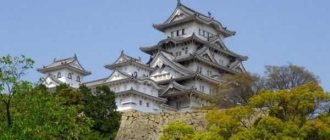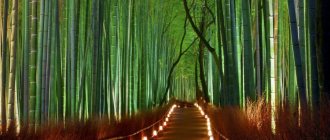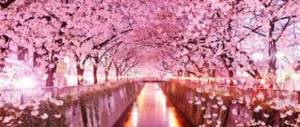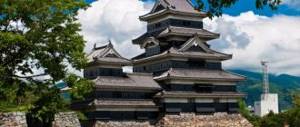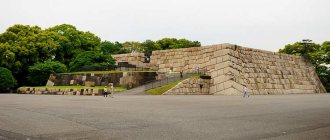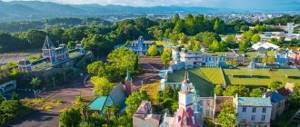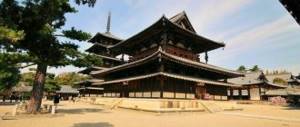Castles of the Land of the Rising Sun. They are not like European fortresses. Another people, another culture. Built centuries ago, few of them have survived to this day.
Osaka Castle is one of those that managed to survive. Time, elements, wars have left their marks on it. Osaka has risen from the ruins more than once. It’s all the more interesting to wander around the park around the citadel, admire the modern city from above, walk through the floors, and touch the history of this unique place.
Osaka Castle - landmarks of the past
Japan, late 16th century. The commander Toyotomi Hideyoshi ordered the construction of a fortress in the city of Osaka. At the same time, more than 30 thousand workers built this citadel: they laid huge boulders in the foundation, poured a stone embankment, and erected walls decorated with gilding.
A supporter of the idea of unifying the country, Toyotomi made the castle the economic center of Japan. All trade routes then led to Osaka. This building has a difficult fate, as does the entire Japanese people.
- 1598 . Soon after the construction was completed, Hideyoshi dies, leaving behind his wife and young son, Hideyori. Before his death, he forced the feudal lords to recognize his son as ruler and appoint a council of elders. Only soon did shogun Tokugawa Ieyasu break his oath. Osaka Castle then became the only refuge for Hideyori and his supporters.
- 1614 . The Tokugawa army, having numerical superiority, was unable to achieve victory. The fortress did not surrender. A peace treaty was signed. But treachery seems to have been Tokugawa Ieyasu's hallmark. When retreating, his troops filled ditches around the citadel.
- The year is 1615. While they were trying to restore the ditches, Tokugawa attacked again and this time successfully. Toyotomi Hideyori and her mother committed suicide, and the castle was completely destroyed.
- 1620–1629 Hidetade, son of Tokugawa Ieyasu, restores the fortress. All that remains from the former are the ditches and the central courtyard.
- 1665 The main tower is struck by lightning. As a result of the fire, it was completely burned out. Almost 300 years later, in 1931, Osaka residents raised money and built a new tower.
- The year is 1868. The war between north and south. The castle was badly damaged; only a few utility rooms remained intact.
- 1942–1945 Firebombing destroyed everything that remained. The fortress was completely turned into ruins.
- 1995–1997 What little remains are being reconstructed. The rest is being rebuilt.
In fact, only the lower part of the walls, several gates and three corner towers have survived to this day. And then there is the history of the citadel: victories and defeats, truth and fiction.
Modern reconstructions
The very first reconstruction of the castle (Osaka-jo) in the 20th century was carried out in 1931. The main tower, having risen from the ruins, acquired a beautiful modern appearance. Local authorities carried out a major reconstruction using reinforced concrete.
At the end of World War II, elements of the castle were again damaged by air raids by American pilots, but they were restored again from 1995 to 1997. During the latest restoration, earthquake-resistant structures were added, and an elevator was added to the main tower. Today the facility is open to tourists.
Our days
In the center of the city, on a stone embankment, this fortress raises its walls to a height of 20 meters. Around the walls are wide ditches filled with water and a sakura garden.
Nowadays, to get inside, you don’t need to be under siege for months. The castle gates are always hospitably open. In the courtyard, guests are greeted by a monument to Toyotomi Hideyoshi. One of the walls depicts the battle of 1615.
Eight floors (three of them underground). Each floor is a museum. Exhibitions, puppet shows, large-format images - all this is the history of the fortress through the eyes of our contemporaries. Most of the exhibitions located on the floors are temporary. Exhibits are updated every few months. For a fee, visitors are allowed to try on the military clothing of samurai commanders.
On the ground floor there is a cinema room where you can watch a film about the castle and its founder. On the eighth floor there is an observation deck and a souvenir shop. You can go upstairs by elevator or stairs.
Next to the castle garden is a stadium where public events and concerts often take place.
What interesting things can you see in Osaka?
Before the eyes of tourists appears a tall twenty-meter building with impregnable stone walls. A picture of a brutal samurai battle can be seen on one of these walls. The castle is surrounded by long, deep moats filled with water.
Panorama of Osaka Castle
The entrance to the castle grounds is through the huge stone gate of Otemon. Osaka consists of five towers of varying styles. The Japanese call this structure the Tower of a Thousand Eyes. Here on the territory of Osaka you can see several small barracks.
Panorama inside Osaka Castle
The interior of Osaka has been completely changed. The Japanese were unable to restore it to its original form. Currently, a huge national museum is located inside the castle. There are a large number of spacious exhibition halls here. Osaka has a unique collection of various historical items. All exhibits and excursions of the museum are dedicated to the founder of Osaka, the military leader Toyotomi. In some halls, tourists can watch interesting historical films. Thanks to spacious modern elevators, you can easily move around all floors of the castle.
At the very top of Osaka, tourists will be able to admire the picturesque landscapes spread around.
Note to tourists
Osaka Castle is open to visitors from 9:00 to 17:00 daily. He does not receive guests for only five days - from December 28 to January 1.
The entrance ticket costs 600 yen (4.2 euros). For children under 15 years old - admission is free.
You can get there:
- Metro. The nearest station is Tanimachi 4-chrome.
- Bus. Get off at the “Babacho” or “Otemon” stop.
- River tram. Go to the “Osaka Castle Pier” stop.
Osaka Castle
Video: Osaka Castle
Story
The castle was built in 1585-98 by the commander Toyotomi Hideyoshi, modeled after the Azuchi Castle, which Nobunaga Oda built for himself ten years earlier. Hideyoshi tied the most important trade routes of Japan, divided by many years of civil strife, to Osaka. During his reign, the area adjacent to the castle (now the city of Osaka, the second largest in Japan) became the focus of the entire economic life of the country.
The castle, covering one square kilometer, sits on top of a stone embankment designed to protect against attacks by sword-bearing warriors. Huge boulders are laid at its base, the largest of which reach six meters in height and fourteen meters in width. The castle has five floors; three more underground levels go deep into the embankment. From 20 to 30 thousand people were simultaneously employed in construction.
In 1614, during the war between Hideyori (Hideyoshi's son) and the powerful shogun Tokugawa Ieyasu, the castle withstood a siege by two hundred thousand troops. Tokugawa was unable to take the fortress, but he managed to fill up the ditches surrounding it - a key element of Osaka's fortification system. The following year, Hideyori attempted to restore the outer moat and fill it with water. The enraged Tokugawa sent a detachment of his warriors to Osaka, who captured the enemy castle. Hideyori and his mother committed suicide; the place of their death is marked with a memorial sign.
In 1620, Tokugawa ordered the reconstruction and expansion of Osaka Castle. In 1665, lightning striking the main tower led to a devastating fire. In subsequent years, the castle was restored, but burned again in 1868, during the dramatic events of the Meiji Restoration. The Brockhaus and Efron Encyclopedic Dictionary notes that by the beginning of the 20th century, only ruins remained of the castle, and the remaining premises were converted into a barracks. The main tower (tenshukaku) rose from the ruins and acquired its modern appearance only in 1931, when local authorities carried out a major reconstruction using reinforced concrete.
At the end of World War II, the castle buildings were damaged by American air raids, but were restored in 1995-97. The site is currently open to tourists; The interiors of the main tower are modern. Adjacent to the castle garden is a stadium where world-class musicians touring throughout Japan perform.
What to see
Osaka Castle is built on two rock platforms with sheer walls more than 20 meters high - these are the largest stone walls in Japan. They are surrounded by ditches up to 90 meters wide, with a total length of 12 kilometers. The central building consists of five floors on the outside and eight on the inside.
Of the original structures, the main Otemon gate, five Yagura towers (tower of a thousand eyes) from the Tokugawa period, moats, several barracks and houses remain. The stones of the buildings were laid without mortar, which allowed them to withstand earthquakes.
The eight-meter wall depicts the summer battle in Osaka, in which 400 thousand samurai took part.
The interior of the castle has not been restored to its original form. It is set up like a museum, complete with modern elevators. All nine floors are exhibition halls that tell the life story of Hideyoshi Toyotomi, and in some halls there are projectors that show short educational films. On the eighth floor you can enjoy one of the best panoramas of Osaka.
If you want to see the original medieval interior of Japanese castles, visit the largest castles in Japan: Matsumoto, Himeji, Aizu-Wakamatsu, Nijo, the impregnable Gifu Fortress and one of the oldest in Japan - Inuyama Castle.
Practical information
Osaka Castle is open from 9.00 to 17.00 (entrance until 16.30). Closed from December 28 to January 1.
Cost: 600 yen (about 4.2 €), children under 15 years old – free.
The museum explains some of the exhibits in English and also offers brochures in English.
How to get there: the nearest metro station is Tanimachi 4-chrome, Tanimachi and Chuo lines. The nearest JR station is Osakajokoen, Circle Line.
Official website: www.osakacastle.net
Himeji Castle
Now we have approached the castle, all that remains is to cross the road.
Previously, Himeji Castle was called Shirasagi-jo: - “White Heron Castle”. It gets its second name partly from the fact that it resembles a bird preparing to fly to the skies.
I already wrote about it in a previous article about Himeji Castle, but here I’ll just write about what I haven’t written before + I’ll just post photos of the castles against the backdrop of sakura, because... these places are truly transformed against its background.
When I was here last time, the entrance to the main tower was closed due to restoration, but this time we managed to go into the main tower of Himeji Castle.
And I want to tell you that I didn’t like the inside and despite the fact that I really adore this castle, the floor inside is very cold (and you are forced to take off your shoes) and there is a strong wind.
And this would not be so scary, but especially during the sakura period there are a lot of people there and therefore the queue moved very slowly, and every minute it became colder and colder.
Despite all the coolness and fabulousness of this place, I lost all my enthusiasm when I entered there. However, in fairness, I want to point out that the view from Himeji Castle is simply amazing.
For me, Himeji Castle is one of the coolest places in Japan.
It’s especially cool to be here during the cherry blossom season. Traditionally, television comes here to film sakura.
We can say that for me this is a reference place for combining a medieval castle with sakura.
If you love Japanese castles and sakura, then you definitely need to visit this place.
Since Himeji Castle, like other surviving castles in Japan, is built of wood rather than stone, fire protection is very important.
Therefore, both the walls and all external parts of the building are covered with white lime.
Himeji Castle is one of my favorite places! You can come here at least every week and not get tired of it! 
And the price of 1000 yen (about $9) seems ridiculous compared to the experience you will get by visiting this place!
Well, late in the evening we returned to Osaka, where our next hotel was located.
